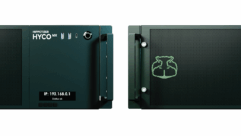A Kansas Town Rebuilds Green After Disaster
Kansas Gov. Kathleen Sebelius and several others saw a rare opportunity for Greensburg to rise from the rubble as the greenest town in America.
Credit: BNIM Architects, Kansas City, MO
THE WORLD’S LARGEST HAND-DUG WELL has long been the claim to fame for Greensburg, Kan. At the time of its completion in 1888, the well was considered a masterpiece of pioneer engineering. However, the town’s identity changed forever on May 4, 2007, at about 9:30 p.m., when the citizens of Greensburg found themselves directly in the path of a 1.7-mile- (2.7-km-) wide twister. One of 25 tornados that were reported in southwest Kansas that night, Greensburg’s twister stayed on the ground for 22 miles (35 km) and 30 minutes and had wind speeds reaching 205 mph (330 km/h).
Twelve residents lost their lives to the monstrous storm. Less than one in 10 buildings remained standing; the rest were obliterated completely. The Silver Spring, Md.-based National Weather Service rated the tornado an EF-5, the most powerful level for a tornado, and President Bush declared a major disaster.
Credit: Sheila Samuelson
Among the wreckage and the rush of emergency aid crews and news teams that descended on the town in the days following the storm, a vision of Greensburg’s recovery began to emerge. Kansas Gov. Kathleen Sebelius and several others saw a rare opportunity for Greensburg to rise from the rubble as the greenest town in America. “Why rebuild to 1950 standards when you can rebuild for the 21st century?” Sebelius asked.
Since then, Greensburg’s resilient residents, businesses and all levels of government have begun working toward this vision. Recognizing a need in the community, locals Daniel Wallach and Catherine Hart founded Greensburg GreenTown, a nonprofit devoted to assisting community members with information about and resources for green rural development.
“Rural Kansans already live lightly and close to the Earth, from hanging their wash [out to dry] to combining trips into the city, so helping them to take that mindset one step further with their built environment isn’t hard. Especially when they will see their utilities drop from about $250 per month down to $50 per month, which we think is a very realistic goal,” Wallach says.
Greensburg GreenTown has drafted a plan in which corporate donor teams will design and build 12 model homes, each showcasing different green- building design, technology and products. The homes will be operated by the nonprofit as bed-andbreakfast lodging for Greensburg’s guests and serve a vital role in the developing town’s new, green
“At a time when green building fits into the slim budget of affordable housing, there’s little reason not to incorporate efficiency into all buildings,” says developer Jay Manske.
Credit: BNIm Architects, Kansas City, MO
Greensburg may soon have a green-home certification unique to the town. The draft checklist is loosely modeled after Energy Star and LEED standards. Citizens who rebuild their homes to meet “Greensburg Green” standards may receive recognition on a registry and incentives from the city.
Commercial businesses also are participating in the town’s green-building movement. Dwane Shank Motors, Greensburg’s General Motors dealership, doesn’t intend to miss out on the energy savings or exposure that will come with being a rebuilt green city. Designs for the new dealership include energy-efficient skylights, clerestory windows and light shelves to maximize daylighting. Bathrooms will feature waterless urinals, dual-flush toilets and faucet aerators. Building materials, such as high R-value recycled cellulose insulation, will be sourced locally.
Greensburg city officials are resisting the urge to rebuild quickly by embracing a long-term vision for sustainable growth and economic development that will support residents for generations. BNIM Architects, Kansas City, Mo., is developing a downtown master plan for Greensburg that reflects the town’s new identity. The preliminary plan features many hallmarks of low-impact development, including narrow streets and widened permeable sidewalks lined with native vegetation. Rainwater collected in downtown cisterns will be used for watering plants. Advanced street lighting will minimize light pollution, and low-energy LEDs will be used for stoplights.
While Greensburg has not formally committed to achieving LEED certification for municipal buildings, Stephen Hardy, AICP, an associate with BNIM Architects expects that city hall, a hospital, conference center, fire and police stations, and schools will be designed to meet LEED specifications. The most effective way to achieve sustainability is to design sustainably from the beginning. Greensburg has that to its advantage. In five years, another masterpiece may join the Big Well in Greensburg; this time it will be the city itself, a model of systemic green planning and design.
Credit: BNIM Architects
>>SHEILA SAMUELSON is a graduate student at Presidio School of Management, San Francisco, where she is working toward a Master of Business Administration in sustainable management. She spent summer 2007 in Greensburg, Kan., helping the green recovery effort. Samuelson can be reached at [email protected].










